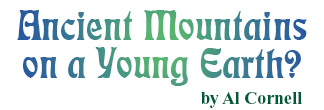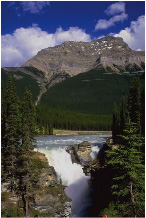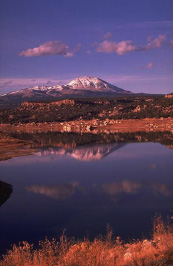

As a member of the Creation Research Society, I devoured all the material presented in their journal and eventually contributed a few book reviews and a short article to that publication. During the 1970s, I contributed articles to the Firm Foundation. Most of them dealt with God and nature, and five contended specifically for the young earth concept.
 Yet, my devotion to that concept
failed to sustain faith in it. Toward the end of the 1970s, I
became convinced that something was woefully wrong with the flood
geology belief system. I went silent on the subject of earth
age. This is the first that I have written on it in over 30
years. Now that I perceive Genesis 1
differently, I am content to let God speak, and I do not feel compelled
to defend an interpretation. Though I am bothered that some
young-earth advocates are dogmatic, I am not motivated to exhibit the
contention that was evident in my earlier writings. That is why I
could remain silent on the subject for so long and now write with
trepidation.
Yet, my devotion to that concept
failed to sustain faith in it. Toward the end of the 1970s, I
became convinced that something was woefully wrong with the flood
geology belief system. I went silent on the subject of earth
age. This is the first that I have written on it in over 30
years. Now that I perceive Genesis 1
differently, I am content to let God speak, and I do not feel compelled
to defend an interpretation. Though I am bothered that some
young-earth advocates are dogmatic, I am not motivated to exhibit the
contention that was evident in my earlier writings. That is why I
could remain silent on the subject for so long and now write with
trepidation.
I do not perceive earth-age as an issue we need to be contentious about, yet I understand the contention as one who used to promote it. I used to think that all believers thought the earth was young until nineteenth century geology set off the conflict. However, nearly all Christian writers from the second and third centuries who mention the subject present an interpretation on Genesis 1 that promotes a longer time frame than six days. It is worth noting that this topic was never an issue causing dissension in the early church.
I live near the edge of the glaciated and non-glaciated landscapes. My undergraduate study of soils had left me with a perplexing question of why both land forms and soil formation appeared so vastly different between the two areas. The non-glaciated soils and land forms seemed to be many times older than those of the glaciated areas. Eventually I decided they look that way because they are indeed many times older, and neither could possibly fit my earlier concept of flood geology.
The main technique for aging the earth is by the measurement of radioactive decay. Several different isotopes converge by indicating an age of a little over four billion years. They constitute convincing proof that the earth has not always been here. For anyone who is interested, the decay of Rubidium 87 to Strontium 87 is fascinating. While measuring radioactive decay constitutes a science that is used substantially throughout the earth, the only objection brought against it is to search through the literature for examples where it obviously did not work because of contamination or some error. The technique is way too accomplished to be discredited by some mistakes that have arisen while using it.
 In the heavens, supernova from over 100,000 light-years
away have led to some young-earth advocates proposing that light used
to travel many times faster than it does today. In contrast,
physicists have been discovering many things about the universe that
are extremely fine tuned and that appear to demand a Creator.
There is evidence that, in order to have the kind of universe that
exists, the speed of light could not vary.
In the heavens, supernova from over 100,000 light-years
away have led to some young-earth advocates proposing that light used
to travel many times faster than it does today. In contrast,
physicists have been discovering many things about the universe that
are extremely fine tuned and that appear to demand a Creator.
There is evidence that, in order to have the kind of universe that
exists, the speed of light could not vary.
My last three paragraphs have introduced a few things that do not harmonize with either flood geology or a young earth. A more detailed study of these and a number of other phenomena of the universe caused me to take another look at the Sacred Text. I know some throw up a red flag at this statement proclaiming, "That's letting science dictate your interpretation of Scripture." However, if we believe God is Maker of the cosmos and Author of the Word, our search unifies into an expectation of harmony. My young-earth concept left me with no hope of finding that harmony.
Modern science was born out of a community that placed great emphasis on its interpretation of the Bible. While Galileo personally did not struggle with his concept of science and religion, others brought pressure to bear against his scientific discoveries.
 Copernicus' work related to the
relationship of earth to the sun earned for him the following remark
attributed to Martin Luther, "This fool Copernicus wishes to reverse
the entire science of astronomy; but sacred Scripture tells us that
Joshua commanded the sun to stand still and not the earth." We
have gone past Luther's problem with the text of Joshua
10:12-13 and realize how foolish it would be to insist that the sun
revolves around the earth. Yet, by looking at the text, it is
easy to understand how being devoted to a literal interpretation
prompted Luther's remark.
Copernicus' work related to the
relationship of earth to the sun earned for him the following remark
attributed to Martin Luther, "This fool Copernicus wishes to reverse
the entire science of astronomy; but sacred Scripture tells us that
Joshua commanded the sun to stand still and not the earth." We
have gone past Luther's problem with the text of Joshua
10:12-13 and realize how foolish it would be to insist that the sun
revolves around the earth. Yet, by looking at the text, it is
easy to understand how being devoted to a literal interpretation
prompted Luther's remark.
Science undermined some other concepts that people held to be religious truth. Flat-earth defenders had a hard time letting go of the "four corners of the earth." Also Revelation speaks of a third of the stars falling to earth. A third of a few thousand little light specks in the sky does not sound like much. However, a third of a billion trillion massive stars helps us to concentrate on the meaning of the figurative text rather than to expect the Big Bear to come tumbling down along with assorted galaxies.
Now, when we consider Genesis 1, we are dealing with events that occurred at some time in the past. That makes it easier to confuse the issue and to not concede that science has located another error in our interpretation of the Bible. As a consequence, many, who are compelled to accept the science related to the phenomena discussed in the previous paragraphs, dig in their heels and attempt to explain away the science of an old earth. Some folks have produced movies that persuade entire congregations that the old-earth concept is an evolutionary conspiracy to undermine the Word of God. As a consequence, this present conflict of religion versus science, primarily in America, does not appear to be going away any time soon.
 To the extent that the scientific community understands
Christianity
to be a young-earth religion, it perceives Christianity to be built on
myths that contradict science. This errant view of Christianity,
caused by a particular interpretation of Genesis 1,
creates a major difficulty for young Christians entering scientific
fields. As they progress in their study of science, most
encounter a significant problem. Some lose faith. Some come
to the realization that their faith is in no way dependent on the
young-earth view. A few persist with a personal conflict by
accepting old-earth science and young-earth Christianity.
To the extent that the scientific community understands
Christianity
to be a young-earth religion, it perceives Christianity to be built on
myths that contradict science. This errant view of Christianity,
caused by a particular interpretation of Genesis 1,
creates a major difficulty for young Christians entering scientific
fields. As they progress in their study of science, most
encounter a significant problem. Some lose faith. Some come
to the realization that their faith is in no way dependent on the
young-earth view. A few persist with a personal conflict by
accepting old-earth science and young-earth Christianity.
An awesome portion of the Word, Genesis 1 combines dynamic with concise. It strikes at the root of any religion or science that blurs the distinctions between God, man, other living things, and the inanimate. God is referenced 38 times, setting Him apart as Creator of all. It conflicts sharply with ideas contained in naturalism, paganism, polytheism, New Ageism, and Eastern religions. It emphasizes earth and man because it focuses on questions of human existence and purpose.
It blends a poetic essence into a prose substance in the eight acts of creation beginning at day one, each with, "And [or 'Then'] God said." Check out how the first four acts line up chronologically with the last four. They contain a parallelism that in any other section of Scripture would lead to the allowance of some poetic license.
We appreciate the morning stars singing together while the earth's
foundation was being laid in Job 38:4-7,
though we know inanimate objects do not sing and young-earth folks
would believe they had not been created yet. That same God who
spoke to Job could incorporate some figurative language when revealing
the great mystery of creation in Genesis 1.
Most of us are persuaded that those commentating on Scripture can cause
us undo confusion by pretending to have a complete understanding of all
things. Some also force a totally literal  interpretation on the beginning text. This
pretense of complete knowledge of such great mysteries leads to
self-promotion and religious dissension.
interpretation on the beginning text. This
pretense of complete knowledge of such great mysteries leads to
self-promotion and religious dissension.
A problem arises because most people do not have a lot of time to devote to this subject. As a consequence, they are vulnerable to accepting the first or most persistent view they are exposed to. There is no easy answer here, and I would encourage people to expose themselves to some natural science as well as to read some material from the young-earth folks. In addition to Does God Exist? materials, read some from the Intelligent Design movement and throw in some Hugh Ross, Gerald Schroeder, Frances Collins, or others. Unfortunately, all of these viewpoints can be persuasively represented, creating initial confusion as to who is right. Yet, in time, one begins to see through some of the weaknesses. In the meantime, it is easier to take a more humble attitude toward Genesis 1 and other creation passages.
From the beginning of modern science, Christians made the mistake of expecting science to be the ultimate confirmation of their theology. In reality, science proved some of the theology to be in error. It also proved to be totally incapable of finding and turning over a rock beneath which God abides or finding ultimate answers to what had once appeared to be a rather simple cosmos. We still walk by faith. God will keep it that way till the end. Because of the magnificence of His handiwork, many of us are influenced to praise His glory; however, we accept that science will never penetrate the shadow of James Russell Lowell's poem, "... And behind the dim unknown standeth God within the shadow, keeping watch above His own."
In Genesis 49:26 Jacob refers to the ancient mountains and the age-old hills. Some people maintain that those hills and mountains formed during the flood and were a mere 6,000 years old. I think this text presents them as being considerably older.
Back to Contents Does God Exist?, NovDec08.